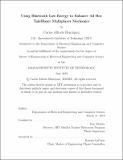| dc.contributor.advisor | Eric Klopfer. | en_US |
| dc.contributor.author | Henríquez, Carlos Alfredo. | en_US |
| dc.contributor.other | Massachusetts Institute of Technology. Department of Electrical Engineering and Computer Science. | en_US |
| dc.date.accessioned | 2019-12-05T18:07:25Z | |
| dc.date.available | 2019-12-05T18:07:25Z | |
| dc.date.copyright | 2019 | en_US |
| dc.date.issued | 2019 | en_US |
| dc.identifier.uri | https://hdl.handle.net/1721.1/123174 | |
| dc.description | This electronic version was submitted by the student author. The certified thesis is available in the Institute Archives and Special Collections. | en_US |
| dc.description | Thesis: M. Eng., Massachusetts Institute of Technology, Department of Electrical Engineering and Computer Science, 2019 | en_US |
| dc.description | Cataloged from student-submitted PDF version of thesis. | en_US |
| dc.description | Includes bibliographical references (pages 85-86). | en_US |
| dc.description.abstract | TaleBlazer is an educational mobile game platform designed to build location-based augmented-reality learning games. While most games for TaleBlazer are designed as single-player experiences, there are many benefits to be gained from player-to- player in-game interactions. This thesis introduces a robust and flexible protocol for peer-to-peer communications between TaleBlazer players using Bluetooth Low Energy (BLE), an API for further feature development using BLE, and an interface for game designers to leverage those features. I introduce the concept of teams over BLE in TaleBlazer to facilitate player-to-player communications, which allows members of the same team to communicate with each other without risk of their communications being intercepted by other teams. The protocol and API used for these teams are modular and extensible to simplify future development of player-to-player interactions via BLE. | en_US |
| dc.description.statementofresponsibility | by Carlos Alfredo Henríquez. | en_US |
| dc.format.extent | 86 pages | en_US |
| dc.language.iso | eng | en_US |
| dc.publisher | Massachusetts Institute of Technology | en_US |
| dc.rights | MIT theses are protected by copyright. They may be viewed, downloaded, or printed from this source but further reproduction or distribution in any format is prohibited without written permission. | en_US |
| dc.rights.uri | http://dspace.mit.edu/handle/1721.1/7582 | en_US |
| dc.subject | Electrical Engineering and Computer Science. | en_US |
| dc.title | Using Bluetooth low energy to enhance ad hoc TaleBlazer multiplayer mechanics | en_US |
| dc.type | Thesis | en_US |
| dc.description.degree | M. Eng. | en_US |
| dc.contributor.department | Massachusetts Institute of Technology. Department of Electrical Engineering and Computer Science | en_US |
| dc.identifier.oclc | 1129456301 | en_US |
| dc.description.collection | M.Eng. Massachusetts Institute of Technology, Department of Electrical Engineering and Computer Science | en_US |
| dspace.imported | 2019-12-05T18:07:24Z | en_US |
| mit.thesis.degree | Master | en_US |
| mit.thesis.department | EECS | en_US |
